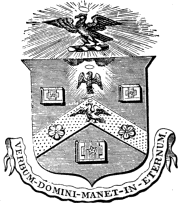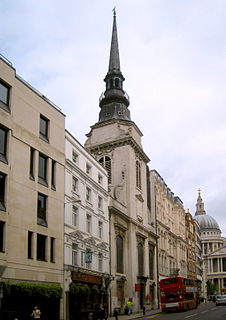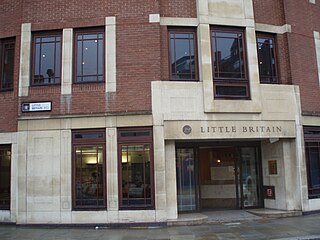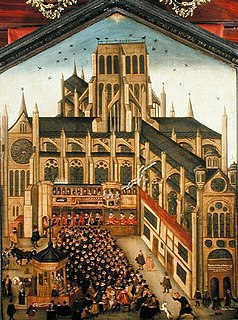
The Hail Mary is a traditional Christian prayer addressing Mary, the mother of Jesus. The prayer is based on two biblical episodes featured in the Gospel of Luke: the Angel Gabriel's visit to Mary, and Mary's subsequent visit to Elisabeth, the mother of John the Baptist. The Hail Mary is a prayer of praise for and of petition to Mary, regarded as the Theotokos. Since the 16th century, the version of the prayer used in the Catholic Church closes with an appeal for her intercession. The prayer takes different forms in various traditions, and has often been set to music.

The Worshipful Company of Stationers and Newspaper Makers, usually known as the Stationers' Company, is one of the livery companies of the City of London. The Stationers' Company was formed in 1403; it received a royal charter in 1557. It held a monopoly over the publishing industry and was officially responsible for setting and enforcing regulations until the enactment of the Statute of Anne, also known as the Copyright Act of 1710. Once the company received its charter, "the company’s role was to regulate and discipline the industry, define proper conduct and maintain its own corporate privileges."

Cheapside is a street in the City of London, the historic and modern financial centre of London, which forms part of the A40 London to Fishguard road. It links St. Martin's Le Grand with Poultry. Near its eastern end at Bank junction, where it becomes Poultry, is Mansion House, the Bank of England, and Bank station. To the west is St. Paul's Cathedral, St Paul's tube station and square.

Wynkyn de Worde was a printer and publisher in London known for his work with William Caxton, and is recognised as the first to popularise the products of the printing press in England.
"Ave verum corpus" is a short Eucharistic chant that has been set to music by many composers. It dates to the 13th century, first recorded in a central Italian Franciscan manuscript. A Reichenau manuscript of the 14th century attributes it to Pope Innocent

Compline, also known as Complin, Night Prayer, or the Prayers at the End of the Day, is the final church service of the day in the Christian tradition of canonical hours, which are prayed at fixed prayer times. The English word is derived from the Latin completorium, as compline is the completion of the waking day. The word was first used in this sense about the beginning of the 6th century by St. Benedict in his Rule, in Chapters 16, 17, 18, and 42, and he even uses the verb compleo to signify compline: "Omnes ergo in unum positi compleant" ; "et exeuntes a completorio" ….

The Angelus is a Catholic devotion commemorating the Incarnation or the Annunciation. As with many Catholic prayers, the name Angelus is derived from its incipit—the first few words of the text: Angelus Domini nuntiavit Mariæ. The devotion is practised by reciting as versicle and response three Biblical verses narrating the mystery, alternating with the prayer "Hail Mary". The Angelus exemplifies a species of prayers called the "prayer of the devotee".
The EC postcode area, also known as the London EC postal area, is a group of postcode districts in central London, England. It includes almost all of the City of London and parts of the London Boroughs of Islington, Camden, Hackney, Tower Hamlets and Westminster. The area covered is of very high density development. Deliveries for the EC postcode area are made from Mount Pleasant Mail Centre.

"Alma Redemptoris Mater" is a Marian hymn, written in Latin hexameter, and one of four seasonal liturgical Marian antiphons sung at the end of the office of Compline.

The Second Great Fire of London in December 1940 was caused by one of the most destructive air raids of the Blitz during World War II. The Luftwaffe raid caused fires over an area greater than that of the Great Fire of London in 1666, leading one American correspondent to say in a cable to his office that "The second Great Fire of London has begun". Fires started by the raid included an incendiary bomb that broke through the dome of St Paul's Cathedral, which was being guarded by a fire watch team at the behest of the Prime Minister Winston Churchill.

Paternoster Row was a street in the City of London that was a centre of the London publishing trade, with booksellers operating from the street. Paternoster Row was described as "almost synonymous" with the book trade. It was part of an area called St Paul's Churchyard.

St. Martin's Le Grand is a former liberty within the City of London, and is the name of a street north of Newgate Street and Cheapside and south of Aldersgate Street. It forms the southernmost section of the A1 road.

St Martin, Ludgate, also known as St Martin within Ludgate, is an Anglican church on Ludgate Hill in the ward of Farringdon, in the City of London. The church is of medieval origin, but the present building dates from 1677 to 1684 and was designed by Sir Christopher Wren.

Little Britain is a street in the City of London running from St. Martin's Le Grand in the east to West Smithfield in the west. It is situated in the Aldersgate and Farringdon Within wards. Postman's Park is also bounded by Little Britain.

Foster Lane is a short street within Cheap ward, in the City of London. It is situated northeast of St Paul's Cathedral and runs southbound Gresham Street to Cheapside.

St Paul's Cross was a preaching cross and open-air pulpit in the grounds of Old St Paul's Cathedral, City of London. It was the most important public pulpit in Tudor and early Stuart England, and many of the most important statements on the political and religious changes brought by the Reformation were made public from here. The pulpit stood in 'the Cross yard', the open space on the north-east side of St. Paul's Churchyard, adjacent to the row of buildings that would become the home of London's publishing and book-selling trade.

Amen Corner is a street located off Ave Maria Lane, just to the west of St. Paul's Cathedral and between the Old Bailey and Paternoster Square, in the City of London.

The Locomotive Publishing Company was an English publishing house, specialising in railway topics. It was noted for publishing Locomotive Magazine, amongst many other highly regarded titles. It was also notable as one of the first stock photo libraries, in this case specialising in railway images.

The Oxford Arms in Warwick Lane was one of the last surviving galleried coaching inns in London and stood near St Paul's Cathedral between the 17th and late 19th centuries.

Ave Maria by Franz Biebl is a motet composed for double choir, a large four-part choir and a three-part choir which can be performed by soloists. It is a setting of part of the Latin liturgical Angelus prayer, which contains the Ave Maria as a refrain. The composition was originally written for men's chorus, but the composer wrote arrangements for mixed choir and women's choir. The work and arrangements were published by Wildt's Musikverlag, first in 1964. The piece first became famous when a U.S. group, the Cornell University Glee Club, included it in their Christmas programs, and more famous when the Chanticleer ensemble made it part of their regular repertoire. It was published in the U.S. by Hinshaw and became one of the publisher's best-selling items.



















